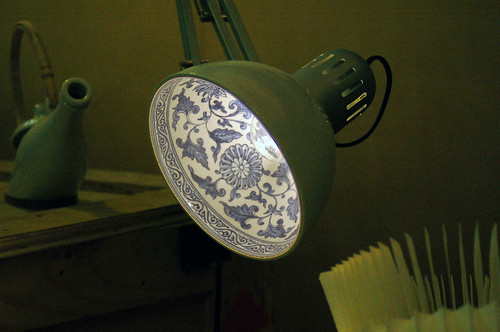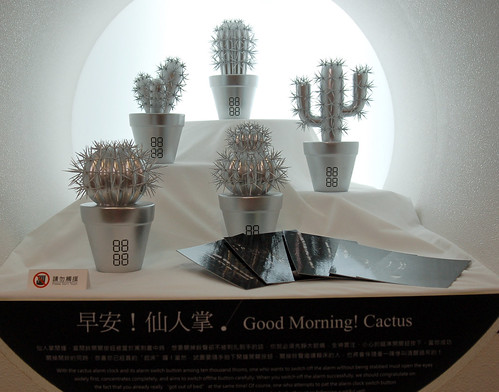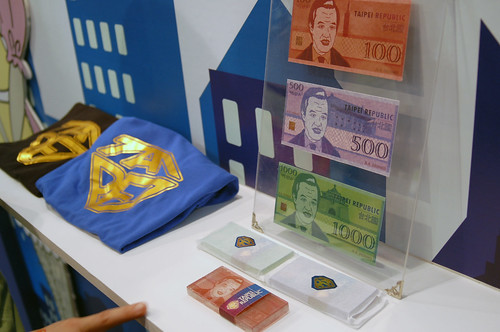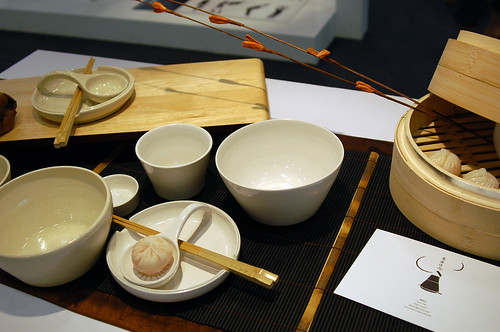If you’ve ever seen those little green foam protective covers on fruit, then you’d understand this designer’s desire to beautify function. This is one student’s design. Thousands of students participate in YODEX. Around 60 universities from Taiwan and 22 international universities participate in this exhibition occupying two entire exhibition halls at the Taipei World Trade Center adjacent to the landmark Taipei 101 building. I was invited to go by my residency host, Chih Wei, whose alma mater, National Yunlin University of Science and Technology was represented. She explained to me that each student’s work was chosen by jury, and most of the students who were given the opportunity to exhibit were showing what would be considered their thesis work. Some of the work was by non-graduating students, but this is unusual because of the time, resources and funding that goes into it.
 Each University represented a specific department with in their school. By specific, I also mean unique and uber niche; for example, Dayeh University represented their Department of Plastic Art. Other departments included Multimedia and Game Science, Multimedia and Entertainment Science, Digital Content and Animation Design, Techno-Craft Design, Styling and Cosmetology, Technological Product Design, Fashion Imaging; and, of course, Industrial Design, Arts and Design, Visual Communication Design, etc. Within almost every School and Department we toured, we found ceramics! Yea! And, duh. Taiwan has an extremely rich history in that regard, and in the contemporary designs, historical references appeared here and there. Here is Chih Wei standing in front of an elaborate display of various ceramic designs. The light behind her actually looks like Ming Dynasty porcelain inside—a simple, pleasing design idea that actually brings the idea, as opposed to the material, of traditional ceramics into industrial design.
Each University represented a specific department with in their school. By specific, I also mean unique and uber niche; for example, Dayeh University represented their Department of Plastic Art. Other departments included Multimedia and Game Science, Multimedia and Entertainment Science, Digital Content and Animation Design, Techno-Craft Design, Styling and Cosmetology, Technological Product Design, Fashion Imaging; and, of course, Industrial Design, Arts and Design, Visual Communication Design, etc. Within almost every School and Department we toured, we found ceramics! Yea! And, duh. Taiwan has an extremely rich history in that regard, and in the contemporary designs, historical references appeared here and there. Here is Chih Wei standing in front of an elaborate display of various ceramic designs. The light behind her actually looks like Ming Dynasty porcelain inside—a simple, pleasing design idea that actually brings the idea, as opposed to the material, of traditional ceramics into industrial design. Another designer recognizes the need for compact, all-in-one dishware while catering to traditional Taiwanese food. Steamed soup-dumplings have actually become one of my favorite eats and here. They are little pasta pouches filled with cabbage and pork soup that you dip into a soy and ginger sauce, and place on your spoon, then you break the noodle membrane letting it mix with the soy and slurp the whole thing into your mouth. Yum. The designer has replaced the wooden steam box on the right with a personalized set of ceramic ware that stacks up neatly, chopsticks too, into a single object with graceful curves (you can see a little illustration in black of the stack on a card just below the wooden steam-box).
The designers’ products and displays ran the gamut of what can be considered art, design, craft and visual communication in every material imaginable. Some focused on “Green” design, some on the design of new objects, some on packaging design, some on the design of an experience in which objects and images were like supportive props, and some focused on purely conceptual objects. Digital images, animation and computer programming constituted a considerable amount of the exhibition space as well, but since I’m an object maker fascinated by material and its plead for innovation, my attention was swayed by presentations satisfying my interests.
A tennis court squeegee, in which dead tennis balls are cut and inserted into a reservoir using their interior rubber to create the water-pushing part of the implement, was an example of environmentally conscious design, or “thinking green”.

An alarm clock in the form of a potted cactus doesn’t seem all that innovative until it is understood that in order to turn off the alarm, the waking must find the sprig of needles that is the off/snooze button. Not so easy to slip back to sleep after that, eh?
The tennis squeegee and cactus alarm were quietly presented accompanied by simple illustrations, however, that wasn’t the case with all designs. Innovation in the design and packaging of cotton swabs was nearly secondary to the theatricality of its presentation. The walls of this booth were decorated with the cotton swabs in a way that created a soft, bas-relief lace pattern, and the girls promoting their designs donned frilly white dresses covered in the same. Oh, and lets not for get the cotton tiaras. Chih-wei informed me that many Taiwanese are fans of Japanese culture, and this kind of sickeningly cute and girly celebration is very Japanese in nature. Interestingly, even at a prestigious national design exhibition, the girls’ product and persona was more than acceptable, it was lively, fun, popular and successful. I was smiling and excited about cotton swabs and so was everyone else that inquired about their designs!
 Another popular booth was an entire immigration center for a fictional “Taipei Republic”. Complete with a silly form to fill out and a nonsensical quiz to take before your identification card picture was taken. It was free to receive your I.D. card via e-mail, and a printed souvenir would set you back a nominal sum. I have yet to receive mine, but I haven’t checked the junk mailbox yet. Other souvenirs were for purchase as well such as handmade soap with the image of the President Ma on it, little trading cards and t-shirts reading “Tai-pei” in the shape of . . . what else but . . . the Superman logo. We entered through the “Entrance” gateway looking much like the airport metal detectors, and exited through a similar “Departure” gateway. The whole thing was very entertaining, and politically charged, but Chih Wei and I didn’t discuss the details of how this fabricated republic’s comical immigration experience was viewed in that respect. We were having a good time, and a conversation about politics through translation in the middle of a crowded exhibition hall seemed like it would put a damper on things. There was plenty to be inferred here. Since we both decided to indulge in this designer’s world, I figured nothing too horrible would come of giving out my e-mail address, signing my name and having my picture taken . . . uh . . . well, I guess I can’t take it back now.
Another popular booth was an entire immigration center for a fictional “Taipei Republic”. Complete with a silly form to fill out and a nonsensical quiz to take before your identification card picture was taken. It was free to receive your I.D. card via e-mail, and a printed souvenir would set you back a nominal sum. I have yet to receive mine, but I haven’t checked the junk mailbox yet. Other souvenirs were for purchase as well such as handmade soap with the image of the President Ma on it, little trading cards and t-shirts reading “Tai-pei” in the shape of . . . what else but . . . the Superman logo. We entered through the “Entrance” gateway looking much like the airport metal detectors, and exited through a similar “Departure” gateway. The whole thing was very entertaining, and politically charged, but Chih Wei and I didn’t discuss the details of how this fabricated republic’s comical immigration experience was viewed in that respect. We were having a good time, and a conversation about politics through translation in the middle of a crowded exhibition hall seemed like it would put a damper on things. There was plenty to be inferred here. Since we both decided to indulge in this designer’s world, I figured nothing too horrible would come of giving out my e-mail address, signing my name and having my picture taken . . . uh . . . well, I guess I can’t take it back now. A couple of neatly conceptual objects, a “stiletto” chair and a “corset” mirror, both by the same designer, really struck my fancy intellectually. This sleek, plastic chair was made at angles matching that of a stiletto pump with only a tiny flat place for resting your rear. The illustration next to the chair shows the proper way to sit: your bum on the little flat space with knees together and back strait as a board seeming to ask great effort on the sitter’s part. The illustration also showed other, non-acceptable ways to sit in the chair each depicting drooping limbs or a hunched back. I think I’ll leave you to contemplate the metaphor on your own. The “corset” mirror, whose casing was also a simple white plastic, was not like a “fun-house” mirror. It was just a plane old mirror that had plastic covers in the shape of a corset so that the only part of your torso left to view in the mirror was a small strip in the center, curving slightly out at the shoulder and hip heights. The mirror only makes you look thinner by denying your view of the rest—ha ha.
Ok, so, design catering to a unique cultural heritage, and political art sometimes need translation, but touring this exhibition was the opposite of wandering aimlessly in a foreign country. That’s the great thing about art and design, they are their own language, and its one I understand. You do or will too, because good design speaks to elements such as humor, beauty, food and metaphor, of our contemporary lives that are simply human.
Look for the “Good Morning Cactus” and “Dressing Fruit” protectors at stores near you soon.
You can view more pictures of our tour of YODEX on my Flickr page.








